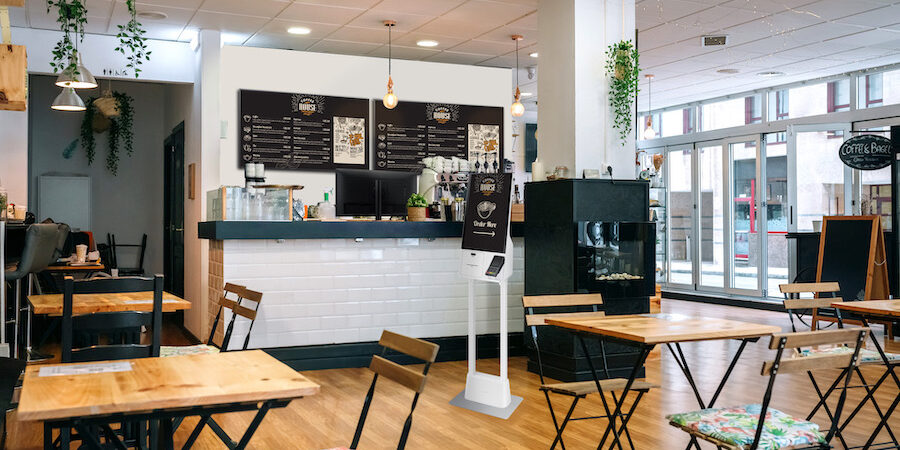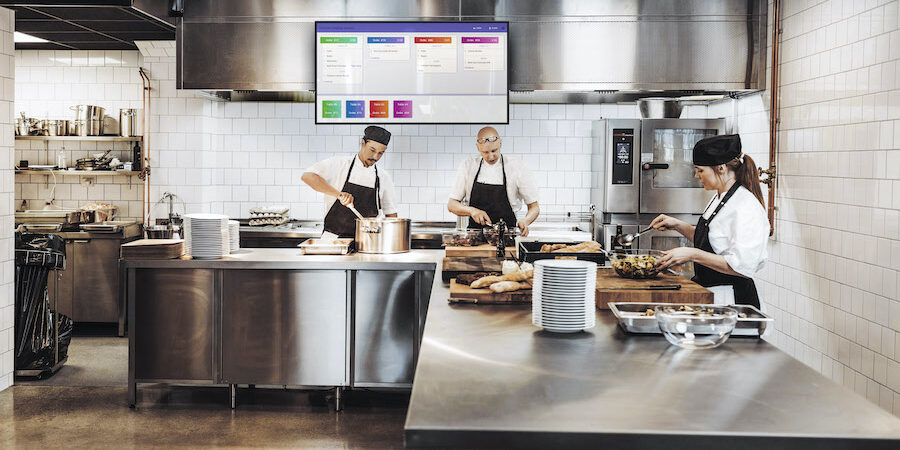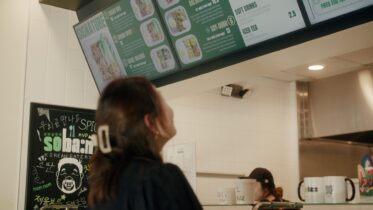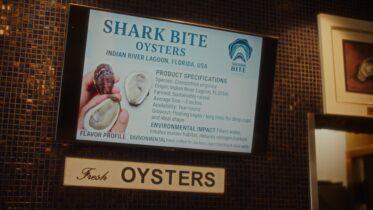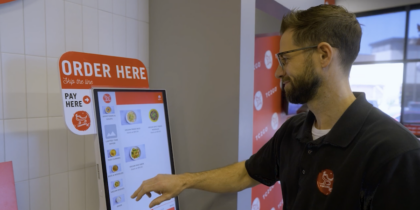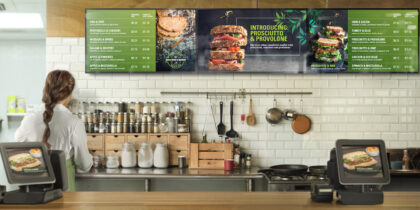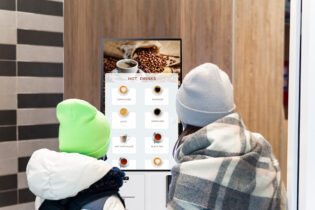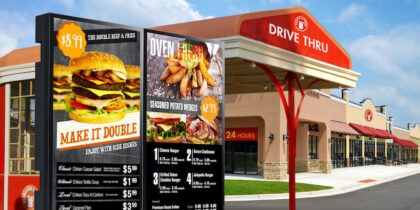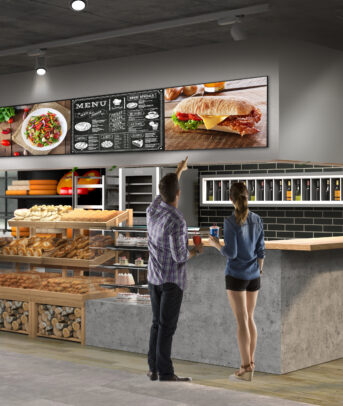For small and medium-sized businesses (SMBs) in the food and beverage industry, developing menus with tantalizing dishes and drinks that keep customers coming is crucial to success. However, achieving that can also depend on the menu boards themselves. If faded, stationary, or outdated, they might actually repel customers, especially if the competing restaurant, café, shop, or bar down the street deploys menu boards that outshine yours.
An electronic menu board or self-service kiosk can make a significant impact on sales because they are much easier to see, speed the ordering process and streamline business operations. They also ensure menus stay current, with any changes in products or prices highlighted in real time. Personalization tools also enable better cross-selling and upselling. Furthermore, digital menu boards can help ease some of the challenges facing the food and beverage industry, such as the ongoing worker shortages and the rising cost of food, by offloading some human duties onto digital solutions.
Learn how digital menu boards can elevate your food and drink business, especially when paired with a robust content management system (CMS), such as Samsung VXT.
How to display menus with digital signage
Digital menus are an important sales and marketing tool. Displaying a menu on bright, high-definition screens with bold fonts and attention-grabbing photos of food and drink items improves menu visibility and can drive impulse buys. In fact, 54% of consumers in a TransUnion survey say that attractive menu items influence where they eat.
Elevate your QSR by empowering employees
Explore how key technologies can help QSRs stay competitive and mitigate growing industry problems. Download Now
Food and beverage SMBs, from sports and hotel bars to cafés and restaurants, can implement digital signage for menus to catch customers’ attention and maximize sales.
- Digital signage can be installed in many places — behind the counter, at a drive-thru and in storefront windows. That’s due to the many shapes and sizes available. Samsung QB Series 4K displays, for example, range from 43 to 98 inches.
- Food and drink purveyors can use digital signage to display promotions, such as new food items for the summer, happy hour specials or limited-time discounts.
- Digital menus display the product with maximum vibrancy, visible in all conditions. A good example is the waterproof Samsung OHA-S Series, which features anti-reflection technology and has a built-in auto brightness sensor that automatically adjusts brightness to lighting conditions.
- Through self-service kiosks, customers can study the menu, place their orders, and pay without staff assistance, streamlining ordering, reducing wait times, and improving operational efficiency.
- Digital signage — such as self-service kiosks, storefront window digital displays and guest order boards — can also provide order confirmation. Customers can visually check their orders before paying, which eliminates mistakes, improves customer satisfaction and streamlines operations. The same goes for order status, showing customers where their food or drink is at any moment, freeing staff from being hounded for updates.
How a CMS supports the creation of digital menus
To deploy digital menus, restaurant and beverage SMBs must pair digital displays with a good CMS. That’s because the CMS enables business owners to design, create, deploy and manage all content on digital displays — and from a single device at any location. That’s particularly important for businesses with multiple locations, owners, and staff off-premises.
More importantly, a solid CMS like Samsung VXT features a content creation and management tool for digital menu board design. Through a drag-and-drop interface, users can use VXT Canvas software to design and build menus using hundreds of digital menu templates and free stock images. They can also use their custom logos, fonts and photographs to create visually appealing menus that align with their brand. Samsung VXT allows managers to schedule the content displayed on digital signs. For example, if a quick-service restaurant is launching several new dishes, they can design and pre-schedule promotions to run on the digital displays in the drive-thru for the next few weeks. The Content Journey Map then shows the screen list that has published the content and the spaces to which the content has been shared.
Samsung VXT has become even more ideal for SMBs in the food and beverage industry because it is cloud-based, easy to use and affordable. Instead of buying servers and installing software, they can simply subscribe to the cloud-based software and pay a monthly or yearly subscription. It also has built-in security to keep data safe from cyberattacks. If you run into any questions or issues, the new Chat Bot feature can help address them.
How restaurants benefit from digital menu boards
Many features of digital menus particularly benefit restaurants. When paired with a CMS, the digital signage allows food and beverage businesses to daypart their menus, automatically changing menus and promotions for breakfast, lunch and dinner.
They can also update the menu and prices and introduce new specials at any time based on demand, inventory, weather, or what the competition is doing. For example, if sales for the day are slow, a restaurant owner can encourage more by displaying a buy-one-get-one-free offer on a storefront digital display.
Restaurant and beverage SMBs can also integrate Samsung VXT with point-of-sale (POS) systems, ensuring that menu items and pricing on the digital displays are always up to date. For example, Samsung software supports Wisar Digital’s Link My POS software, which connects the CMS to POS systems. It enables the POS system to automatically sync menu and pricing data with VXT software.
Food and beverage SMBs can also use digital displays to display nutritional and allergen information. They can also promote the restaurant’s social media channels and display positive customer reviews. Another way to do this is by welcoming groups via the displays, like a pizzeria welcoming a Little League team that just won the championship game. Or it might highlight other upcoming events, such as trivia night. If the restaurant is near a sports stadium, they can attract fans seeking a postgame meal with specials and promotions — designed with the team colors — on their window digital displays. These can capture customers’ attention, improve customer service, increase operational efficiencies and bolster sales.
Technology that works together
To benefit from digital menu boards, SMB owners need the right technology tools to work together. Fortunately, Samsung delivers both the tools and the together with Samsung VXT and Samsung digital displays. The first creates the dynamic content, and the latter displays it in vibrant graphics, text and media that will catch any eye.
Check out the latest VXT product updates and features, and discover more about how Samsung is helping food and beverage outlets improve the customer experience with technology in this free white paper. Also, learn more about how self-service kiosks and devices are reinventing customer service at restaurants, cafés and bars.
